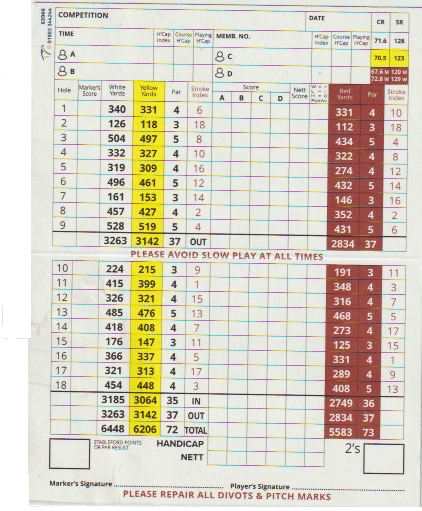Collecting your golf scorecard
Firstly let me first start off by saying how we get hold of our first golf scorecard, This can be obtained when you visit the golf course, simply check in at the club’s shop (pro shop).

A golfer’s score on each hole during a round is recorded on a scorecard. Usually, the course will supply the scorecard, which has a grid for each hole and spots for each player to enter their score. It also includes the course’s overall par as well as the par for each individual hole.
Depending on the type of course and the competition being played, scorecards may differ slightly. Some scorecards offer information in addition to the score, such as the yardage of each hole, the number of strokes used, and any penalty strokes that were used.
A golfer keeps track of his score on a scorecard after finishing each hole. Each player is in charge of tracking his or her own score and accurately recording the number of shots they have taken. The scorecard also acts as a guide for the player as they navigate the course by listing the most challenging holes and their respective yardages.
PARS
The number of strokes required to accomplish a hole or course is known as a golf par. For instance, a 4-par hole means the player must finish it in four shots.
For scoring reasons, a golfer’s total strokes are compared to the par score to determine whether they were “above par,” “under par,” or “even with/equal to par.”
The distance between the teeing area and the putting green, as well as occasionally additional elements like terrain and obstructions, determines the par value of a hole, which is often between three and five. A standard 18-hole golf course will have a total par of around 72, and a 9-hole par-3 course (where every hole is classed as a par 3) will have a total par of around 71.
COURSE RATING
The USGA Course Rating System is typically used to calculate the course rating, which is a numerical indicator of a course’s difficulty for scratch (or “zero handicap”) players. Higher numbers denote a more challenging course, with course ratings often falling between 68 and 78. Each set of tees on a golf course receives a course rating from the USGA Course Rating System. The rating is determined by the distance of the course from the longest set of tees, the topography, and any play-impairing hazards.
The rating is a projection of the typical score a scratch golfer might achieve on the course. The course rating is intended to represent the typical round score of a scratch golfer, or a player who can shoot inside par.
YARDAGES
The yardage on a golf course is the measurement between the teeing area and the hole in yards or meters. Golfers can choose the best club and execute precise shots by knowing the actual yardage of a course.
There could be up to five sets of tees or yardage options on a golf course. On the scorecard, you can find the yardage for each set of tees arranged in rows. Every set of tees has a name, such “gold tees” or “red tees,” for example. Each player’s score is recorded in rows in the middle of the scorecard, with a different column for each hole. A bigger box for the player’s name and boxes to tally the score for each nine holes and the overall 18-hole score are located on the left side of each row.
HANDICAP
A golf handicap is a number that is given to a player that accurately reflects their level of ability and the approximate number of strokes needed to reach even par. The better the golfer, and vice versa, the smaller their handicap.
The golf handicap system was created as a way to gauge a player’s talent level by weighing scores from several rounds against the relative difficulty of the courses they were playing. Golfers can compete against players of various skill levels and talents by using handicaps. When and if a player receives strokes on a hole during a competition, they can use the stroke index of the course.
A golfer with a handicap of 0 is referred to as a “scratch golfer,” and on a USGA-approved course, they may expect to shoot even par. A “bogey golfer,” on the other hand, will have a handicap of 18, meaning that his score indicates that he averaged a bogey on each of the 18 holes of the course, giving him a score of 18 over par and a handicap of 18. Men can have handicaps up to 36, while women can have handicaps up to 40, according to the USGA. A large handicap is typically defined as one of 20 or more.
HANDICAP PURPOSE
In scramble or tournament play, a handicap is best employed to level the playing field and provide a baseline by which golfers may track their development. To level the playing field, a golfer with an 18-handicap may have 18 strokes deducted from his final score at the conclusion of a round, whereas a golfer with a 4-handicap may only lose four strokes. For the latter, a golfer’s handicap, on the other hand, enables them to accurately assess their development. For example, if a golfer went from having a 22 handicap to having a 12, she would have lost 10 strokes from her average round.
COURSE AND SLOPE RATING
A golfer’s handicap also takes into account the course and slope rating. Scratch golfers can predict the course’s difficulty based on its rating. A scratch golfer might, for instance, shoot a round with a course rating of 72. While bogey golfers can learn their expected score from a round’s slope rating.
HANDICAP’S TERMS
To determine a player’s handicap for a certain round of golf, you must understand two key terms on a golf scorecard. The first is the course’s slope, while the second is its rating. Each is related to a certain golf ability level. The predicted score of a scratch golfer playing a round of golf on a course is known as the course rating. The projected score of a bogey golfer in relation to the course rating is known as the slope rating, and the average slope rating is 113.
